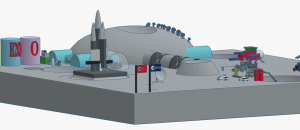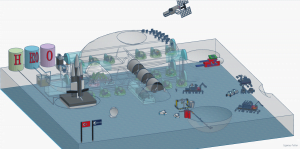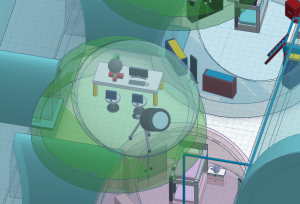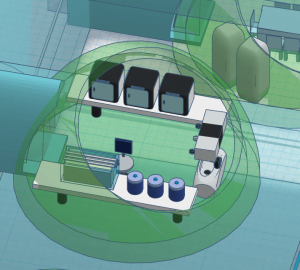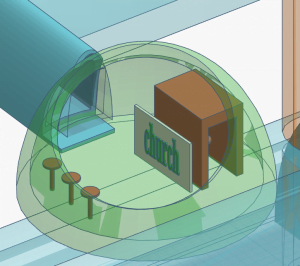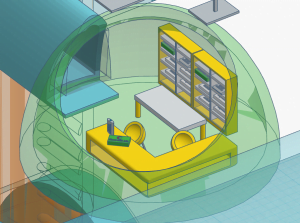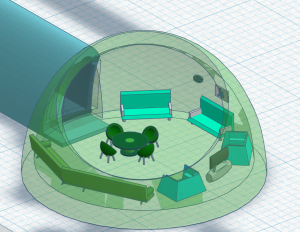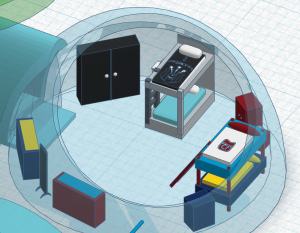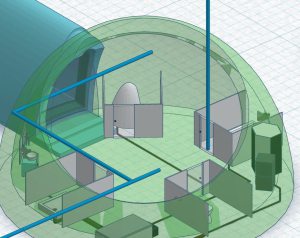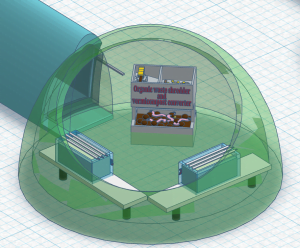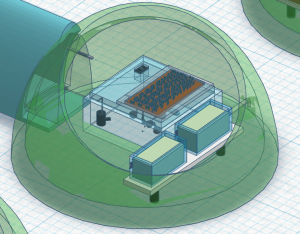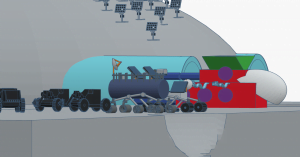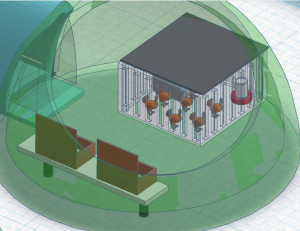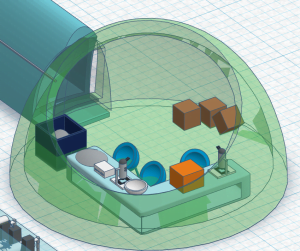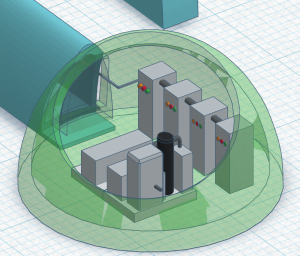Moon Camp Explorers Gallery 2020-2021
In Moon Camp Explorers each team’s mission is to 3D design a complete Moon Camp using Tinkercad. They also have to explain how they will use local resources, protect astronauts from the dangerous of space and describe the living and working facilities.
Team: BİLSEM Moon Campers
Bartın Science and Art Center [EN] (Bartın Bilim ve Sanat Merkezi [TR]) Bartın Turkey 10, 11
External link for 3d
|
Project description
We set it up by 3D printing using local resources on the moon. We used regolith to produce the glass, solar panels and building materials we needed. We have processed lunar glaciers and turned them into potable water. After these waters were used, we sent them to the treatment facility and made them reusable. Sustainability is very important for our camp. We made the sources of hydrogen, oxygen, carbon dioxide required for water, food and air sustainable. In order to meet our sustainable carbon needs in the camp to be built on biological systems, carbon dioxide scavengers will circulate on the surface of the moon and collect the carbon dioxide discovered by Apollo. The astronauts who will take part in the camp will have different specialties. These areas of expertise are biologist, geologist, material scientist, electrical engineer, chemist, computer engineer. In addition, all astronauts have a good command of many areas, especially space engineering and basic medical support. The CEST time zone is used in the camp to ensure an effective communication with the world. |
|||
|
Where do you want to build your Moon Camp?
Shackleton crater Why did you choose this location?
Moon ice and sunlight are among our most important resources. We planned our camp inside the small hill, near the Shackleton crater at the south pole, to reduce radiation exposure. Our main energy source will be solar energy. For this, we produced solar panels by using radioisotope-thermoelectric generators (RTG) during the camp establishment phase. At Shackleton, we get water, oxygen, and hydrogen from moon ice. The solar energy we receive thanks to the solar panels located around the Shackleton Crater and the foothills of the mountains becomes our main energy source during the day we spend on a lunar day. How do you plan to build your Moon Camp? Which materials would you use?
First of all, a part of the camp is set up unmanned with RTG, robots and 3D printing. Later astronauts join. Other parts of the camp are completed with local resources and biological processes. We use microalgae to provide oxygen and fish food. We produce bioplastic with microalgae and vinegar bacteria. This bioplastic allows us to obtain bullet-proof glass and plastic. RTG will be the energy source of robot-supported glass, solar panels and building materials production tools. In the setup, we capture carbon dioxide, one of the most important steps in photosynthesis, with carbon dioxide capture robots. Explain how your Moon Camp will provide the astronauts with:
|
|||
|
Water
|
Food
|
Electricity
|
Air
|
|
We brought the Moon ice extracted from Shacklaton Crater to the base with transport robots. We obtained water with ice melted in the furnace. We’ve gone through some processes to make the water drinkable. We stored it as water in suitable tanks. We have re-made the wastewater used for drinking, utility and irrigation re-treatment in the wastewater treatment plant. |
Our main food source is fish, chicken and eggs, along with fruits and vegetables produced with aquaponic and hydroponic systems. The European sea bass (Dicentrarchus labrax), which has a shake-resistant egg, is used as a fish because it is close to the hatching time and the travel time to the Moon. The garden in the lunar soil is experimentally cultivated and the fruits and vegetables produced are consumed as food. Vacuumed foods sent from Earth for balanced nutrition are also consumed. Cold storage is used for food storage. |
The main source of electricity is solar panels. In addition, RTG is used. Until the solar panels and camp is established, the main energy source is RTG. RTG is used as an energy source in the production of building materials, glass and solar panels. At the same time, the electrical power is stored in the storage room. Water from moon ice is separated and hydrogen is used as fuel. |
It is used by storing in air, carbon dioxide, oxygen and hydrogen tanks. Systems consisting of hydroponics, aquaponics and microalgae provide oxygen supply. In addition, carbon dioxide is given to the trees in the experimental garden and oxygen is taken from the trees. Since biological systems form the basis of our camp, we capture the carbon dioxide required for photosynthesis with a carbon dioxide scavenger. In this way, we contribute to the carbon cycle. |
|
Describe a day on the Moon for one of your Moon Camp astronauts
Astronaut Feza is a colleague whose specialty is electricity. Astronaut Feza got up at 06:00 in the morning. After a light breakfast, she exercised. Feza went to the study for the daily meeting. At the meeting at 08:00, she talked to ESA and other astronauts in the camp about the previously planned tasks. Astronaut Feza noticed a problem with the sand chamber of the robot-aided glass furnace while examining reports from autonomous devices. She controlled the unit to manage the remotely controlled mechatronic arm repair device. She fixed the problem with the repair device. By that time, it was already time for lunch. All the astronauts gathered in the kitchen for a well-balanced lunch. They ate the meal consisting of chicken and vegetables. After the meal, it was time for the solar panel manufacturer to empty the solar panels on a weekly basis. Astronaut Feza was prepared for a lunar walk. She came to the solar panel manufacturer. Feza, who has performed the moon walk that was her dream since childhood, collected the solar panels and arranged them to join and place them. Returning to the camp again, Feza ate a meal consisting of beef and vegetables from the world with the other astronauts for dinner. Feza went to the room to communicate with her family in Turkey. All the astronauts watched the football game that evening in the living room. Then they spent time together and slept. |
|||


